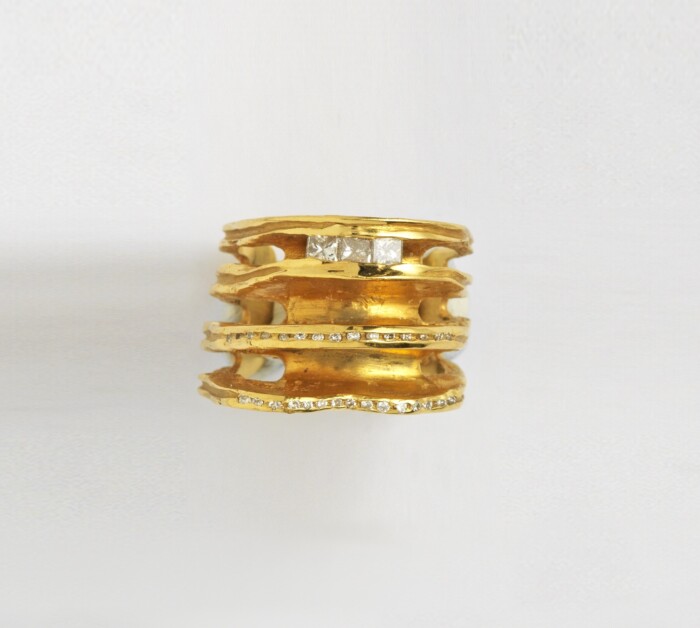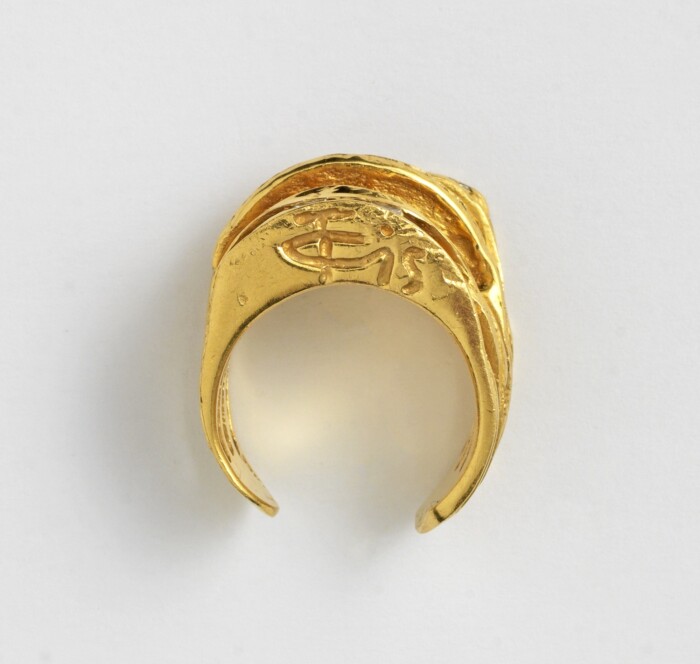| 53 |
Greek, 1925-2019
‘Golden Diamond’ series ring
22 carat gold, diamonds
signed
numbered 1/75 (limited edition series)
weight of gold: 23.7 gr.
weight of diamonds: 0.58 ct.
ring head: 21 x 15 mm
18 mm internal diameter
PROVENANCE
private collection, Athens
| sold for 4,124.75 € |
Takis was born in Athens in 1925. His early years were difficult due to the German occupation and the Greek Civil War that followed it.
He settled in Paris in 1954 where he joined the atelier of Constantin Brancusi for a few months. Influenced by the invention of the radar and the technological landscape of the station of Calais, Takis constructed his first Signals in 1955. Resembling electric aerials, the Signals evolved to become kinetic and flexible, adorned with 'found objects', swaying in the wind, colliding to produce unique sounds. Takis’ Signals were first exhibited at the 'International Exhibition of the Plastic Arts' at the Musée d'Art Moderne de la Ville de Paris in 1956.
Takis had no formal art education, however, by living and working in Paris, New York, London and Athens he synthesized a broad range of ideas and experiences such as intensive scientific research, ancient philosophy, Zen Buddhism, and encounters with other artists and writers, to forge a unique category-defying vision. Time, space, energy and even political activism became the primary material for Takis. He explored the magnetic forces and the energy of magnetic fields, he experimented with electricity, sound and light. Thus, through his art, Takis renders visibility to all these invisible elements.
In 1960 he had his first solo show in New York at the Alexander Iolas Gallery. A year later he meets Marcel Duchamp who will write his famous phrase for Takis: ‘par consequent Takis, gai laboureur des champs magnetiques et indicateur des chemins de fer doux’.
Takis is world-renowned for his investigations of the gap between art and science. Since the early 1950s, he explored new aesthetic territories, creating three-dimensional works of art that incorporated invisible energies as a fourth acting element. He is a leader of the Kinetic art movement and a precursor of the street art performance.
In 1986, he returned to Greece where he established the Research Centre for the Arts and Science in Gerovouno, Attica (its official inauguration was in 1993).
A large-scale retrospective of Takis’ work was exhibited at the Tate Modern in London between July and October 2019, where the spectator experienced the essential poetry and beauty of the electromagnetic universe explored by the artist.
His work is in many leading museums internationally, notably; the MOMA, New York, the Tate Modern, London, the Centre Georges Pompidou, Paris, the Musee d’Art Moderne, Paris, the National Gallery of Greece and the Macedonian Museum of Contemporary Art, to name a few.



